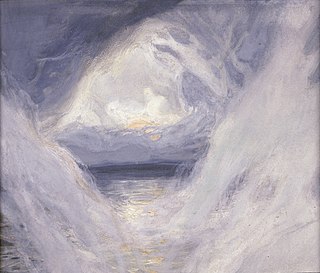Related Research Articles

A creation myth is a symbolic narrative of how the world began and how people first came to inhabit it. While in popular usage the term myth often refers to false or fanciful stories, members of cultures often ascribe varying degrees of truth to their creation myths. In the society in which it is told, a creation myth is usually regarded as conveying profound truths – metaphorically, symbolically, historically, or literally. They are commonly, although not always, considered cosmogonical myths – that is, they describe the ordering of the cosmos from a state of chaos or amorphousness.
In Greek mythology, the Ourea were progeny of Gaia, members of the Greek primordial deities, who were the first-born elemental gods and goddesses. The ourea are also referred to by their Roman name, Montes. They were produced alongside Ouranos, the sky, and Pontos, the sea. According to Hesiod:
And [Gaia] brought forth long hills, graceful haunts
of the goddess Nymphs who dwell amongst the glens of the hills.
Hindu deities are the gods and goddesses in Hinduism. The terms and epithets for deity within the diverse traditions of Hinduism vary, and include Deva, Devi, Ishvara, Ishvari, Bhagavān and Bhagavati.

Batara Kala is the god of the underworld in traditional Javanese and Balinese mythology, ruling over it in a cave along with Setesuyara. Batara Kala is also named the creator of light and the earth. He is also the god of time and destruction, who devours unlucky people. He is related to Hindu concept of Kala, or time. In mythology, he causes eclipses by trying to eat the Sun or the Moon.

Fingering is typically the use of fingers or hands to sexually stimulate the vulva or vagina. Vaginal fingering is legally and medically called digital penetration or digital penetration of the vagina. Fingering may also include the use of fingers to sexually stimulate the anus.

Lebanese cuisine is the culinary traditions and practices originating from Lebanon. It includes an abundance of whole grains, fruits, vegetables, fresh fish and seafood. Poultry is eaten more often than red meat, and when red meat is eaten, it is usually lamb and goat meat. It also includes copious amounts of garlic and olive oil, often seasoned with lemon juice. Chickpeas and parsley are also staples of the Lebanese diet.
Micronesian mythology comprises the traditional belief systems of the people of Micronesia. There is no single belief system in the islands of Micronesia, as each island region has its own mythological beings.
"Here We Have Idaho" is the official state song of Idaho. The music for the Idaho state song, composed by Sallie Hume Douglas, written by McKinley Helm and Albert J. Tompkins, was copyrighted on 4 November 1915, under the title "Garden of Paradise."
In Greek mythology, Paean, Paeëon or Paieon (Παιήων), or Paeon or Paion (Παιών) was the physician of the gods.
Malagasy mythology is rooted in oral history and has been transmitted by storytelling, notably the Andriambahoaka epic, including the Ibonia cycle.

The Three Graces is an oil painting by Italian painter Raphael, housed in the Musée Condé of Chantilly, France. The date of origin has not been positively determined, though it seems to have been painted at some point after his arrival to study with Pietro Perugino in about 1500, possibly 1503-1505. According to James Patrick in 2007's Renaissance and Reformation, the painting represents the first time that Raphael had depicted the nude female form in front and back views.
Paeon or Paion in Greek mythology was a Paionian mentioned in the Iliad of Homer as the father of the warrior Agastrophus, slain by Diomedes, while fighting on the side of Troy in the Trojan War. He is presumably the same as the Paeon mentioned in Quintus Smyrnaeus' Posthomerica as the father by Cleomede of Laophoon, a companion of Asteropaios slain by Meriones.
The concept of an otherworld in historical Indo-European religion is reconstructed in comparative mythology. Its name is a calque of orbis alius, a term used by Lucan in his description of the Celtic Otherworld.
1970s in Andorra:
Rim Kin was a Cambodian writer, and one of the founders of Cambodian modern literature. Published in 1938, he was the author of Sophat, the first published novel in Cambodia, and Cambodian's first modern novel to be written in prose rather than the customary verse form. It became a 1964 movie of the same name. In 1935, the weekly Cambodian newspaper Ratri Thnai Saur was founded and it hosted the first modern serial stories of Kin. From 1955 through 1957, Kin was the first president of the Khmer Writers' Association.

Vasundharā or Dharaṇī is a chthonic goddess from Buddhist mythology of Theravada in Southeast Asia. Similar earth deities include Pṛthivī, Kṣiti, and Dharaṇī. She is the same with Vasudhara bodhisattva in Mahayana and Vajrayana ) and Bhoomi devi and Prithvi in hinduism.

A deity or god is a supernatural being considered divine or sacred. The Oxford Dictionary of English defines deity as "a god or goddess ", or anything revered as divine. C. Scott Littleton defines a deity as "a being with powers greater than those of ordinary humans, but who interacts with humans, positively or negatively, in ways that carry humans to new levels of consciousness, beyond the grounded preoccupations of ordinary life".
This page includes books about Singapore.

The Tan Kim Seng Fountain is a fountain in Singapore that was erected in 1882 in honor of notable philanthropist Tan Kim Seng for his donations for the Singapore’s first reservoir and waterworks.
References
- ↑ C. Scott Littleton; Marshall Cavendish Corporation (January 2005). Gods, goddesses, and mythology. Marshall Cavendish. pp. 1324–. ISBN 978-0-7614-7559-0 . Retrieved 2 January 2011.
- ↑ Miguel Covarrubias (1986). Island of Bali. KPI. pp. 7–. ISBN 978-0-7103-0134-5 . Retrieved 2 January 2011.